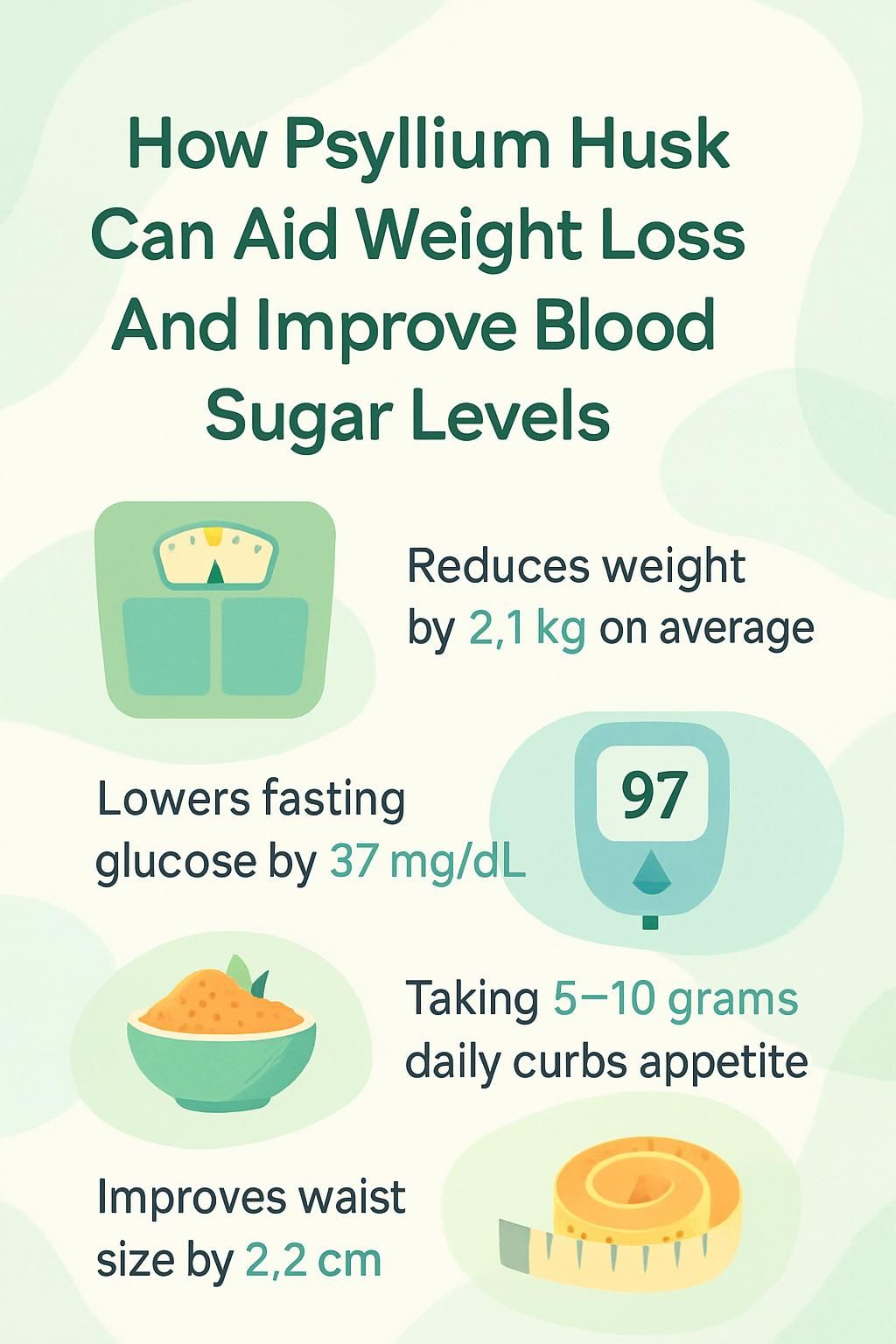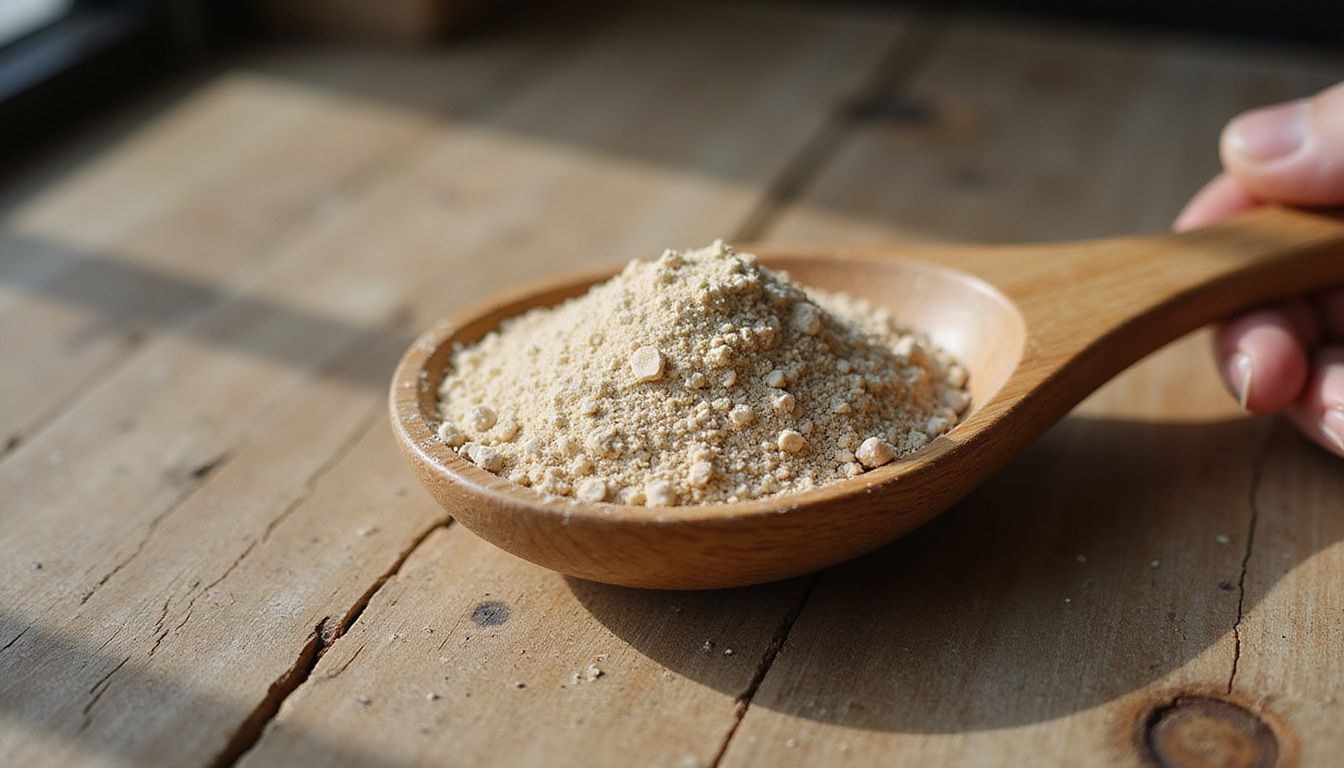How Psyllium Husk Can Aid Weight Loss And Improve Blood Sugar Levels
Our Nutrition Assistant AI Suite will transform your body. You will lose fat, get toned, and build muscle. Gain confidence and optimal health.
If extra weight or high blood sugar has you stuck, you are not alone. Psyllium husk, a soluble fiber from the Plantago ovata seed, can help you take steady steps toward change. This guide explains how psyllium husk may support weight loss and better blood glucose control, plus simple ways to use it each day.
You will see what the research shows, what dose to consider, and how to start safely. Small daily habits add up. With the right plan, fiber can make a real difference.
Key Takeaways
- Psyllium husk can reduce body weight by about 2.1 kg and waist size by 2.2 cm, based on a recent meta-analysis.
- A daily dose of 5 to 10 grams before meals can curb appetite, lower calorie intake, and slow digestion for steadier blood sugar.
- Clinical studies report drops in fasting glucose of 37 mg/dL and HbA1c of 0.97% in people with type 2 diabetes.
- The FDA recognizes psyllium for lowering cholesterol; 7 to 10 grams per day can improve heart health markers.
- Increase fiber gradually and drink plenty of water to limit gas, bloating, or discomfort when starting psyllium.

What is Psyllium Husk?

Psyllium husk is a natural, gel-forming soluble fiber taken from the seeds of Plantago ovata. Many people use psyllium for weight management and blood sugar control because it thickens with water and slows digestion.
Where does psyllium husk come from and what is it made of?
Psyllium comes from Plantago ovata, a crop grown mainly in India. Farmers harvest the tiny seeds, then separate the outer husk, which becomes the fiber supplement sold as powder or capsules.
The husk contains mostly soluble fiber that does not fully break down in your gut. It absorbs water and forms a soft gel as it moves through the intestines. People use psyllium to support healthy weight, lower cholesterol, ease constipation, and even out blood sugar. If you have tried Metamucil, you have already used this type of fiber.
I started adding one teaspoon of psyllium husk to my breakfast smoothie each morning; I found it really easy to mix in and noticed I felt less hungry before lunchtime.
How does psyllium husk function as a soluble fiber?
Once mixed with liquid, psyllium absorbs water and swells into a thick gel. That gel slows how quickly food moves and how fast nutrients are absorbed. This steadier pace can help reduce blood sugar spikes after meals.
You can stir psyllium into oatmeal, yogurt, or baked goods. Many people also notice more regular bowel movements. Because the gel holds water, it adds stool bulk and can ease both diarrhea and constipation. The FDA recognizes psyllium as a helpful dietary fiber for lowering cholesterol. Reviews and meta-analyses describe its role in digestion support, satiety, and weight control through higher fiber intake.
Psyllium Husk and Weight Loss
Psyllium can support weight loss by helping you feel full and by slowing digestion. Research, including randomized controlled trials, suggests psyllium may reduce calorie intake and help lower body mass index.
How does psyllium husk create a feeling of fullness?
Mixed with water, psyllium expands in your stomach and forms a gel. The added volume presses lightly on the stomach walls. This signals fullness, so it gets easier to stop eating earlier.
Studies report that taking psyllium before meals lowers hunger and can reduce daily calories. One trial showed that people who used psyllium before eating felt satisfied sooner and ate less across the day. Many users say it helps curb between-meal cravings without feeling deprived.
My dietitian recommended taking psyllium husk fiber before dinner, and I noticed I felt satisfied much sooner, which made it easier to manage my appetite.
Can psyllium husk help reduce calorie intake?
Yes. Feeling full often leads you to eat fewer calories. In a clinical trial published in the American Journal of Clinical Nutrition, people who took 5 to 10 grams before meals cut about 100 to 200 calories per day on average.
Psyllium works differently from drugs like Ozempic or semaglutide. It forms a gel that slows digestion, which sends clear fullness signals to the brain. Many healthcare providers suggest starting with a small dose, such as a tablespoon mixed in water, especially for those with overweight or obesity.
How does psyllium husk slow digestion to control appetite?
After you take psyllium, it swells into a gel in the stomach and small intestine. This gel forms a gentle barrier that slows how fast enzymes reach food. Stomach emptying takes longer, and nutrients like glucose and fat are absorbed more slowly.
Slower digestion leads to smaller blood sugar spikes, so hunger and cravings are less likely soon after a meal. Guidance from large clinics points to this steadying effect as useful for weight control, diabetes, and irritable bowel syndrome. A meta-analysis of randomized controlled trials found that psyllium use decreased body weight by about 2.1 kg, which supports its role in appetite and satiety.
In what ways does psyllium promote gut health through prebiotics?
Psyllium acts as a prebiotic, meaning it feeds helpful gut bacteria. Good microbes such as Bifidobacteria use this fiber, which can improve digestion and reduce bloating.
Regular use supports bowel health and may aid weight control, including in people with IBS. Many users notice steadier bathroom habits with fewer stomach upsets. This type of fiber supports your gut environment and can improve comfort over time.
Mechanisms Behind Psyllium’s Impact on Weight
Psyllium husk forms a gel in your stomach, which can reduce appetite and support weight loss, like a slow-and-steady traffic light for digestion.
Psyllium’s gel-forming properties in the stomach
When psyllium mixes with water in the stomach, it becomes a viscous gel. The gel expands and occupies more space, so you feel full longer. That fullness can lower calorie intake at meals and snacks.
Digestion also slows, and the stomach empties more gradually. This pacing helps blunt rapid blood sugar rises after carbohydrate-rich foods. Clinical data show lower post-meal glucose levels in people who used psyllium compared to those who did not. Many find that adding psyllium to breakfast keeps them satisfied well into the afternoon.
How does psyllium affect satiety hormones?
The gel slows food movement and extends fullness. This change appears to influence appetite hormones, including glucagon-like peptide-1 receptor signals and peptide YY. These hormones tell your brain to dial down hunger and delay the next bite.
In studies, people who added fiber supplements such as psyllium tended to eat fewer calories at later meals. This hormonal nudge likely contributes to reductions in body weight and waist size over time.
Can psyllium reduce waist circumference and BMI?
Research indicates it can. A comprehensive meta-analysis found an average waist reduction of 2.2 cm, with a 95% confidence interval of 2.9 to 1.4 cm. Body mass index dropped by 0.8 kg/m² on average, with a confidence interval of 1.0 to 0.6 kg/m². These outcomes were statistically significant.
Used along with a healthy diet, psyllium may help reduce obesity-related risks. Better blood sugar control often follows, which supports long-term weight management.
Psyllium Husk and Blood Sugar Regulation
Psyllium can help steady blood sugar by slowing how fast carbohydrates turn into glucose. This is helpful for many people, including those with type 2 diabetes who want steadier energy and fewer spikes.
How does psyllium slow glucose absorption?
After a meal, Plantago ovata husk forms a gel in your gut. This gel traps carbohydrates and slows their movement through the intestines. Glucose then enters the bloodstream at a slower pace.
The Food and Drug Administration recognizes psyllium’s benefits for people who need to manage blood sugar. Studies show psyllium can lower a food’s glycemic response by up to 20 percent. Many people notice fewer energy swings after higher carbohydrate meals.
Can psyllium stabilize blood sugar levels?
Yes. As a soluble fiber, psyllium slows sugar absorption and helps prevent sharp spikes. In clinical research with type 2 diabetes, fasting glucose fell by 37 mg/dL and HbA1c dropped by 0.97%.
Psyllium and Ozempic act in very different ways, yet both can support lower glucose levels. Adding psyllium is a low-cost, food-first step that fits well with routine care.
What benefits does psyllium offer to type 2 diabetes patients?
Psyllium can improve glycemic control and help reduce insulin resistance. The gel slows carbohydrate absorption, which lowers post-meal spikes. Over weeks, that steadier pattern can shape better fasting numbers.
Many people with type 2 diabetes see gains when they include psyllium daily. It is a plant-based, gluten-free fiber that can complement existing care plans.
Evidence from Research Studies
Studies, including systematic reviews and meta-analyses, suggest psyllium can help with weight and blood sugar. The evidence base covers randomized controlled trials and controlled feeding studies.
What weight loss results come from psyllium supplementation?
One systematic review and meta-analysis found an average weight reduction of about 0.44 kg per month. Over a year, that equaled roughly 5.3 kg, which was near 6.1% of the average starting weight in that sample. Reductions in body weight, BMI, and waist size were consistent, with I² reported as 0% in that analysis.
Psyllium appears to aid satiety and reduce calorie intake, which supports weight control. People commonly use powder or tablets within balanced meal plans, including gluten-free approaches.
How does psyllium improve blood sugar in clinical trials?
Clinical trials show improvements in both daily and long-term measures. Participants taking psyllium saw fasting glucose drop by 37 mg/dL and HbA1c decrease by 0.97%. These results suggest fewer spikes after meals and better control over time.
The soluble fiber slows sugar uptake in the gut. Some users simply stir a rounded teaspoon into a smoothie or oatmeal. Many notice steadier post-breakfast readings within a couple of weeks.
What do meta-analyses say about psyllium’s effectiveness?
A recent meta-analysis that focused on higher quality trials found significant weight loss, including an average decrease of 2.1 kg. The included studies enrolled people with overweight or obesity and used well-controlled designs.
Two earlier meta-analyses did not find a clear effect on weight. Differences in study length and design likely explain the mixed findings. Newer reviews support psyllium’s role in decreasing body weight and waist size, and in helping people with high cholesterol or type 2 diabetes.
Health Benefits of Psyllium Husk Beyond Weight Loss
Psyllium can also support cholesterol levels, bowel regularity, and heart health, which strengthens your foundation for daily wellness.
How does psyllium lower cholesterol levels?
Soluble fiber in psyllium binds bile acids in the gut. The liver then uses cholesterol to make new bile acids, which lowers LDL and total cholesterol in the blood.
In people with high cholesterol, daily psyllium lowered LDL by about 5 to 10 percent over several weeks. You can mix it into oatmeal or smoothies, or take it as a supplement. The FDA allows a health claim for psyllium’s cholesterol-lowering effects, and many experts suggest 7 to 10 grams per day.
Can psyllium improve bowel regularity?
Psyllium adds bulk and moisture to stool, which can ease constipation and support regularity. Studies show increased stool output and frequency with daily use.
As a prebiotic fiber, psyllium supports beneficial gut microbes. People with IBS often find it helps normalize stool consistency on both ends of the spectrum. Many dietitians suggest 5 to 10 grams per day with plenty of water.
What cardiovascular benefits does psyllium provide?
Psyllium supports heart health through improvements in LDL cholesterol and total cholesterol. Some studies also report modest reductions in blood pressure, especially in adults with hypertension.
For example, taking about 10 grams daily for 8 weeks lowered LDL cholesterol in several trials. Fiber supplements work best alongside nutritious meals and regular activity. Clinical groups recognize psyllium for managing high cholesterol as part of a comprehensive plan.
Dosage and How to Use Psyllium Husk
Psyllium is simple to add to your routine as powder, whole husk, or capsules. A little planning goes a long way.
What is the recommended daily intake of psyllium husk?
For weight and blood sugar goals, aim for 5 to 10 grams daily. Many studies used 7 to 15 grams per day, with an average near 10 to 11 grams. Most people mix the husk with water, or sprinkle it over foods like yogurt or oatmeal.
Start low and increase slowly to reach your target dose. This helps limit gas and bloating. Always drink a full glass of water with each serving so the fiber can form a smooth gel. If you have kidney disease or take drugs such as Ozempic, check with your healthcare provider before you raise your fiber intake.
When is the best time to consume psyllium husk?
Taking psyllium 15 to 30 minutes before meals can boost fullness and reduce calories at the next meal. Many people mix a serving with water before breakfast, lunch, and dinner.
If you take prescription tablets or other medicines, leave at least two hours between your medication and psyllium. This spacing helps prevent reduced drug absorption and lowers the chance of digestive discomfort.
How can you easily incorporate psyllium into your diet?
Stir psyllium into water or add it to smoothies for a quick fiber boost. Sprinkle it into oatmeal or yogurt, or include it in muffins and pancakes.
It is sold as powder, whole husk, and capsules, so you can match your routine. Many people take a small serving before meals to help with appetite and weight goals. Just drink enough water to keep digestion comfortable.
Potential Side Effects and Safety Considerations
Most people tolerate psyllium well, but a careful start helps. Good hydration reduces most minor issues.
What common side effects might occur with psyllium use?
Gas, bloating, or constipation can happen as your body adapts to more fiber. These effects often fade over days to weeks, especially with enough water. Taking too much without fluids can worsen constipation.
People with medical conditions or on multiple medications should talk with a clinician before starting any new supplement. Begin low and adjust based on how you feel.
Why should you start with small doses of psyllium?
Your digestive system needs time to adjust to higher fiber intake. Starting with a small amount lets you gauge tolerance and reduce the chance of cramping or bloating.
Many people do well beginning with half to one teaspoon daily, then increasing every few days. This slow approach supports gut comfort and keeps you on track.
How important is drinking water when taking psyllium?
Hydration is essential. A common guide is about 500 milliliters of water per 20 grams of fiber across the day. Without enough fluid, psyllium can swell and feel heavy or cause blockage.
Drink a full glass of water with each serving. Good hydration also improves the positive effects on regularity and gut comfort.
Comparing Psyllium Husk to Other Weight Loss Methods
Psyllium is a simple, low-cost tool. It can complement other methods or offer a first step before medications.
How does psyllium differ from medications like Ozempic?
Psyllium is a fiber that works in the gut. It forms a gel, slows digestion, and enhances fullness. This mechanical action helps control appetite and smooths out glucose absorption.
Ozempic affects GLP-1 receptor pathways that influence appetite and insulin. Psyllium does not act on hormones directly. Many people start with fiber because it is accessible and often has fewer side effects.
Is psyllium cost-effective and accessible compared to other methods?
Yes. You can buy psyllium at most supermarkets or pharmacies without a prescription. A large container often costs under $15 and lasts for weeks with daily use.
In contrast, some weight loss drugs can cost hundreds or more per month. Psyllium is easy to mix into water, yogurt, or oatmeal and takes less than a minute to prepare.
Tips for Success with Psyllium Husk
Pair smart fiber habits with everyday choices. Small changes can compound over time.
How can combining psyllium with a healthy diet enhance results?
Use psyllium with meals rich in fruits, vegetables, and whole grains. That combination boosts total dietary fiber, supports steady glucose, and keeps you full longer.
Examples include apples, leafy greens, brown rice, barley, and oats. Meals like these provide vitamins and minerals while fiber helps manage hunger and cholesterol.
Why is regular exercise important when using psyllium?
Physical activity helps your body use fiber more effectively. Movement supports digestion and metabolism, which can improve weight and blood sugar outcomes beyond fiber alone.
Even brief walks count. Many people feel less bloated and more regular when they stay active while using psyllium.
How should you monitor progress and adjust psyllium use?
Track weight, waist size, appetite, bathroom habits, and energy weekly. A simple notebook or app works well.
Start with a small dose, then increase slowly if you tolerate it. If you notice constipation or diarrhea, add more water or reduce the amount. Discuss your plan with a healthcare provider if you have diabetes or other conditions.
Conclusion
Psyllium husk is a practical way to help with weight loss and steady blood sugar. The fiber’s gel promotes fullness, reduces calorie intake, and slows digestion for fewer glucose spikes. Studies also show benefits for LDL cholesterol and waist size, especially when paired with a healthy diet and regular activity.
Start low, drink plenty of water, and build a consistent routine. This article is for education and does not replace medical advice. Talk with your healthcare provider before changing your diet or supplements, especially if you take medication or have a chronic condition.
FAQs
1. How does psyllium husk support weight loss?
Psyllium husk absorbs water in the digestive tract, forming a gel-like substance. This increases feelings of fullness, which can help reduce calorie intake. Clinical studies show that people who take psyllium before meals often eat less and may lose more weight compared to those who do not use fiber supplements. For example, a 12-week trial found that adults taking 10 grams of psyllium daily lost more body fat than those given a placebo.
2. Can psyllium husk help control blood sugar levels?
Psyllium slows the absorption of carbohydrates, which helps prevent spikes in blood sugar after meals. Research published in the American Journal of Clinical Nutrition found that people with type 2 diabetes who took 5 grams of psyllium twice daily had better blood sugar control than those not using fiber supplements. The soluble fiber in psyllium is key to this effect.
3. What is the recommended amount of psyllium husk for these benefits?
Most studies suggest taking between 5 and 10 grams of psyllium daily, split into two doses before meals. It is important to drink plenty of water to help the fiber work properly and avoid digestive discomfort. Always check with a healthcare provider before starting any supplement, especially for those with medical conditions.
4. Are there any side effects or risks when using psyllium husk for weight loss or blood sugar management?
Some people may experience bloating, gas, or mild stomach cramps when first using psyllium. These effects often decrease as the body adjusts to higher fiber intake. Rarely, allergic reactions or blockages can occur if not enough water is consumed. My own experience showed that starting with a small dose and increasing slowly helped avoid discomfort.
Summary: Psyllium husk can help with weight loss and blood sugar control when used as part of a balanced diet and healthy lifestyle. Scientific evidence supports its benefits, but proper use and medical advice are important for safety and effectiveness.







